润滑站使用说明书
成都恒智机电设备有限公司油站使用说明书.-哈密引风机

风机配套高低压稀油站HZ-170L使用说明书成都恒智电机设备有限公司二O一四年四月一、概述 (4)1、产品特点 (4)2、主要用途及适用范围 (4)3、使用环境条件 (4)4、工作条件 (4)二、安全使用注意事项 (4)1、生产日期.................................................................................................................................... 错误!未定义书签。
2、有效期........................................................................................................................................ 错误!未定义书签。
3、错误使用方法或误操作 (4)三、结构特征与工作原理 (5)1、结构特征 (5)2、工作原理 (5)四、技术特性 (7)1、主要性能 (7)2、主要参数 (7)五、尺寸、重量 (8)1、外形及安装尺寸 (8)2、重量 (9)六、安装调试 (9)1、设备安装基础 (9)2、安装条件及安装技术要求 (9)3、安装程序、方法及注意事项 (10)4、现场接线 (10)5、调试程序、方法及注意事项 (10)6、操作调试 (11)7、调试后的验收试验项目、方法和判断依据 (15)七、使用 (15)1、使用前的准备和检查 (15)2、使用中的安全防护及说明 (15)3、运行中的监测和记录 (16)4、停机的操作程序 (16)八、故障分析与排除 (16)1 故障排查表 (16)2 其他故障处理 (16)九、保养、维修 (16)1、工作油液的维护保养: (16)2、日检查: (17)3、月检查 (17)4、年检 (17)5、在日常使用时应注意环节 (17)6、大修 (18)十、运输、贮藏 (18)十一、开箱及检验 (19)十二、技术资料 (19)1、液压原理图 (19)2、地基图 (20)3、外形图 (20)4、仪表接线端子图 (20)5、控制箱图 (20)附表一:常见故障分析与处理方法 (21)附件一 (22)一、概述1、产品特点油站为整体式封闭结构,将润滑站和液压站集成一体。
E363润滑站说明书

一、用途E363润滑站主要用于向提升机减速器及主轴轴承提供润滑油,以降低这些传动副的摩擦系数和发热量。
本稀油润滑站的工作介质为粘度等级N22~N320的工业润滑油。
一般安装在主机附近的地下油库或地坑内,要求减速器及主轴轴承座的回油口高于润滑站回油口300~500mm。
具体布置位置由用户或土建设计确定。
三、工作原理E363型稀油润滑站由油箱、齿轮泵装置、线隙式滤油器和磁性滤油器、列管式冷却器和电加热器以及压力、温度仪表、管道和阀门等组成。
其系统原理见图1。
其工作原理如下:工作时,润滑油由齿轮泵从油箱中吸出,经单向阀、线隙式滤油器、冷却器、控制阀门,被直接输送到提升机的各润滑点,从提升机的各润滑点回油经过回油管路、磁性滤油器重新回到油箱。
本稀油润滑站的最高工作压力为0.63MPa,最低工作压力为0.1MPa,根据润滑点的要求,可通过调节系统安全阀方便地设定润滑系统的工作压力。
当由于某种原因引起系统的工作压力超过设定的压力时,安全阀将自动打开,多余的润滑油直接回到油箱,保证了系统的安全。
四、E363稀油润滑站的特点1.设有2套油泵装置,互为备用,提高了系统工作的可靠性。
本稀油润滑站有2套油泵装置,一台工作,一台备用,在正常情况下,其中的一台油泵装置运行。
当该油泵出现故障时,人工通过电转换开关转换到备用油泵工作,保证向主机连续输送润滑油。
2.线隙式滤油器放在冷却器之前,保证了过滤效果。
润滑油在滤油器中的通过能力与油品的粘度有直接的关系,在润滑油牌号确定后,温度高则润滑油的粘度下降,有利于通过滤油器,从而保证过滤效果;同时,滤油器上装有压差发讯指示装置,当滤油器进出口压差超过规定的值时发出报警信号,提请操作者注意清洗或更换滤芯。
3.采用列管式冷却器,体积小,重量轻,冷却效果好。
4.设计安装了多个电加热器,保证了在冬季高寒地区在不更换润滑油的情况下正常输送润滑油。
5.回油口设有磁性过滤器,可将回油中夹杂的铁质吸附过滤,保证了油的纯度。
XYZ-63GZ稀油站说明书

目录一、用途二、规格和性能三、工作原理四、电气操纵系统五、安装调试和试运转六、操作规程七、维修和安全事项八、常见故障及排除方法九、搬运及贮藏十、开箱检查附:系统图电气原理图接线端子图一、用途XYZ—63GZ型稀油润滑站主要用于冶金、矿山等机械设备的稀油循环润滑系统中,向减速器齿轮、主电机轴承等磨擦部位供送润滑油。
该油站工作介质粘度等级为N22~N320的工业润滑油。
本油站通常是安装在主机附近的地下油库或地坑内。
其他技术参数:冷却水压力:0.2—0.3MPa 换热器进油温度:50℃温降:7—8℃三、工作原理本油站由油箱、油泵装置、双筒网式过滤器和磁性过滤网装置、列管式油冷却器以及电器仪表控制装置、管道、阀门等组成。
工作时,油液由齿轮油泵从油箱吸出,经单向阀、双筒网式油滤器、列管式油冷却器,被直接送到设备的润滑点。
油站的最高工作压力为0.4Mpa,最低工作压力为0.1Mpa。
根据润滑点的需求,通过调节安全阀确定使用压力。
当油站的工作压力超过安全阀的调定压力时,安全阀将自动开启,多余的油液即流回油箱。
本油站的结构有以下特点:(1)设有备用油泵本油站有两台油泵,一台工作,一台备用。
油站工作中,当系统压力低于压力控制器的调定值0.1M时,备用油泵即自动启动进行工作,从而确保主机的润滑需求。
当压力低于0.07MPa时,风机停止。
(2)双筒网式油滤器设置在列管式油冷却器之前润滑油在油滤器中的通过能力与其粘度有关。
油的温度高则粘度低,通过能力好,过滤效果也较好。
所以先过滤后冷却是相当有利的。
(3)采用双筒网式油滤器双筒网式油滤器有两组过滤滤芯。
一组滤芯工作,一组滤芯备用。
当油压压差超过0.05MPa时,人工开启转换阀使备用滤芯工作,即可不停机取出原工作滤芯进行清洗和更换。
此油滤器结构紧凑,接管简单,不设旁路,更换方便。
(4)采用列管式油冷却器本冷却器经优化改进设计,体积小、重量轻、冷却效果好。
在工作压力不高的稀油循环润滑系统中使用是相当合理的。
HRX12195.XYZ-40润滑油站说明书
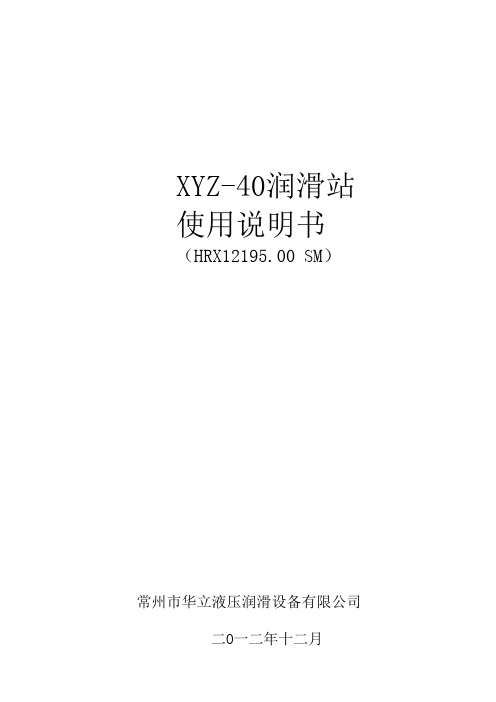
XYZ-40润滑站使用说明书(HRX12195.00 SM)常州市华立液压润滑设备有限公司二O一二年十二月一、用途本设备为鹤岗华鹤煤化30万吨合成氨52万吨大颗粒尿素项目配套用40L/min油站,起减摩及冷却作用,保证主机连续正常运行。
二、技术性能三、主要组成部分的结构特征本稀油润滑系统是由一个容积为0.7m3油箱、二个泵组、一个冷却器、一只过滤器及就地仪表、管道和阀门组成。
油箱、泵组、冷却器及过滤器均安装于底盘上。
油箱是由电加热器、空气滤清器等组成,可以与底盘一起吊装。
1、油箱:本系统油箱是方形的,内部没有筋板,底部是倾斜的,便于清理,没有死角。
单油箱布置,油箱的容积0.7m3,油箱分成几个区域:吸油区和回油区,回油区设有一块隔板,滤除回油中磁性的杂质,提高油液的清洁度。
恒温电加热器自动控制加热器的开停,保持油箱温油。
2、油泵装置:本系统油泵装置采用性能优良的SNH型螺杆泵,泵的振动和噪音均很小,螺杆泵是一种半永久性泵,泵的本身装有安全阀,当出口压力超过1MPa时,油就从出口返回吸入口,可确保泵和系统不会超载。
3、油过滤器:本系统过滤器采用双筒过滤器,一筒工作一筒备用,切换由过滤器上带的压差控制器来控制的,当工作中滤芯逐渐被堵塞,压差达到0.15MPa时,有报警,此时应切换到备用筒,让备用过滤筒投入工作,拆下工作筒中的滤芯,清洗或更换后再装入过滤器内备用。
4、冷却器:本系统采用列管式冷却器。
油温较高时可经过冷却器进行冷却,在冬季或油温较低时,油可以不经过冷却器直接送至设备的润滑点。
四、工作原理稀油站工作时,工作油泵的吸油管将润滑油从油箱内吸出,送入冷却器进行降温,然后经过过滤后,按润滑所要求的油温送到各润滑部位。
润滑油在摩擦表面形成一层油膜,使相对运动付得到润滑,并带走运动付间磨损的金属微粒后,再回到油箱,经过油箱的过滤、沉淀、散热以后再由工作油泵吸出,就这样形成循环系统.五、安装、调整与试运转设备到现场后,首先将油站底盘按地基图方位就位,管道连接好以后把控制线路联接好,并试验电机转向是否和规定的相符。
稀油站使用手册

不使用冷却器,必须关闭冷却器进出水阀(进出水阀及外接管路用户自备),排尽冷却器里
的剩油和水。
7.3、双筒油滤器每三个月进行一次内部检查与清洗。压差超过0.15MPa时,需及时清
洗滤芯,如滤网有抽丝或开裂等现象,应更换。
7.4、注意检察油箱内最低油位处,如发现有水,应打开油箱下部两个放油螺塞将水
排出。
6.操作规程
6.0、向油箱内加注清洁的润滑油。加油量为油箱有效容积的4/5,加注时必须进行过 滤(建议用LUC系列滤油车),否则将严重影响油站和轴承的寿命。
6.1、按系统工作压力及工作油温将供油管路上的电接点压力表(或压力开关)的动 作压力及一只电接点双金属温度计(或温度控制仪表)的动作温度调节到设定值或工况所 需要求值的相应位置,打开稀油站相应的油、水阀门和压力表开关;。
PLC 运行 指示灯不亮 (仅 P 型稀油站)
1.控制电源开关未合上; 2.PLC 上的电源开关未合上; 3.PLC 的 运 行 方 式 未 置 于
RUN; 4.PLC 故障(ERR)指示灯亮。
1.合上控制电源开关; 2.合上 PLC 电源开关; 3.将 PLC 运行方式置于 4.更换 PLC。
RUN;
信号发出。
电控柜用以实现稀油站的自动控制、保护、连锁和故障报警功能,具有就地和远控
操作功能,并具有与中控室连接的 DCS 接口和与主机实现连锁的油站故障停主机接口。
5.安装方式
本稀油站安装时,只要平稳地放在地面上,可不需要地脚螺栓固定。 本稀油站在出厂前已进行过模拟工况性能试验,故在现场安放平稳后,即可连接供油 管、回油管、水管和电控柜,调试正常后,就可投入正常运行。 电控柜由用户自行决定安装位置和固定方式。
3.5 回油口设有磁性过滤器,可吸附油液中铁质微粒,保证油液清洁度要求;
稀油润滑站说明书资料

High-low Oil Lubricating StationOperating ManualCompiled ByChecked ByStandardApproved ByCITIC Heavy Machinery Company, LtdOct. 2005Catalogue1. Summary2. Product Specification and Performance Pedigree3. Operation Principle4. Structural Features5. Main Control Function6. Debug and Operating Regulations7. Daily Operation and Maintenance8. Swing and Setting9. Storage Conditions and Time10.System Schematic Diagram11.Spare Parts List12.Excursus1. Summary:This high and low pressure thin oil lubritory is used for the principal axletree of the ball mill. Each ball mill equips such a lubritory. The high and low pressure oil lubritory is made up of high and low pressure oil supply systems. The high-pressure oil supply system provides static pressure support to the principal axletree at both ends of the ball mill separately while the low one is split in two after effusing the oil to provide the dynamic pressure lubrication.The high pressure oil supply system: the ball mill has to transport the high pressure oil before starting or stopping so that the principal axletree of it floats and the oil film at a certain thickness is formed between the principal axletree and the spherical tile. With the aim to debase the starting moment, otherwise the tile kilning accident, caused by the direct tangency of the principal axletree and the spherical tile, will occur when the ball mill stops if the rotate speed of it is too low to form the required oil filmThe low pressure oil supply system: when the ball mill runs normally, the dynamic pressure lubrication will form between the principal axletree and the spherical tile, which debases the wearing, reduces the power consumption, carries away the generating heat, refrigerates the principal axletree and lengthens the service life of the equipments.The operating environment of this lubritory requires indoor, dry air, no damp, lustration, no noxious gases, no explosivity gases, no aggressive gases wrecking metal and insulation, no conducting dust, no more than 1500 meters altitude and around the 5-40 Celsius degrees.2. Product Specification and Performance Pedigree:The viscosity trademarks used by the working medium of this high and low pressure thin oil lubritory are shown in the operating specification of the main frame.Performance Pedigree:High-pressure oil supply system Normal mode voltage31.5 Mpa (The operating oil pressure is determined by load.)Norminal flow rate 6.0×2 1/minElectromotor Power 5.5×2 KWLow-pressure oil supply system Normal mode voltage0.6 Mpa (The operating oil pressure is determined by load.)Norminal flow rate 63.0 1/minElectromotor Power 3.0×2 KWCooler Cooling water capacity 95-130.0 1/minPressure of the cooling water 0.2-0.3 MPaArea of cooling surface 6.0 ㎡Latus rectum of water intake and water outlet 32.0 mmOil filter Filter precision 80.0Electrical heater Power 2.0×3 KWOil product Viscosity rangeN46-N150 Industrial gear lubrication or antiwear hydraulic oilRecommend N100 antiwear hydraulic oilOil tank Cubage 2.15 Weight2100 Kg3. Operation Principle:The high and low pressure thin oil lubritory is mainly made of oil tank, high-pressure oil pump, high-pressure relief valve, high backpressure valve, electromagnetical diversion valve, high-pressure valve; low-pressure oil pump, low-pressure safety valve, low backpressure valve, oil filter, cooler; pressure controller, humidity controller, electrical crunode thermometer, pressure instrument, pipeline, low-pressure valve and so on.The low-pressure oil pump electromotor has to be started first when the ball mill starts or stops. Then the low-pressure oil pump will draw out the dubbing from the oil tank through diversion valve, oil filter, cooler, low-pressure valve, intermediate piping and flow control device sending to the oil site of the principal axletree at both ends of the ball mill. At the same time, the dubbing drawn out is sent to the input port of the high-pressure oil pump. After the low oil pressure achieves the normal value, the high-pressure oil pump electromotor has to be started. Then the high-pressure oil pump will draw out the high-pressure dubbing changed from the low-pressure one through high backpressure valve and high-pressure valve to the principal axletree of the ball mill. Effusing from the oil site, the lubrication will pass through the oil return port at the principal axletree of the ball mill, the intermediate piping, the oil return filter setted in the oil tank and reflow the oil tank after filtration.This cycle process will ensure the lubricating system work normally.The over-oil-pressure protection to the high and low pressure of the system isfinished by the relief valve and safety valve. When the oil pressure exceeds the setup oil pressure value at the working condition, the relief valve and safety valve will automatically open to step down the pressure in order to realize the overload protection.The operating pressure value of the low pressure system depends on the factors of the opening level of the oil site, the difference of elevation between the lubritory outlet and the oil site, the length of pipeline, the quantity of elbow, and the valve opening and so on.The operating pressure value of the high pressure system is mainly determined by the load and depends on the weight of the ball mill itself and the load, the clearance between the spherical tile and the journal of the principal axletree. The other influential factors are the same as that of the low pressure system.The drain contamination valve on the lubritory is used for quickly eliminating the waste oil which reaches the renewal date and can’t be used ever in the oil tank.Two high-pressure gauges are used for directly observing the oil pressure of the high pressure system. Four high-pressure controllers are used for controlling the oil pressure of the high pressure system. Two low-pressure gauges are used for directly observing the maximum oil temperature warning of low-pressure oilout.One electrical crunode thermometer is used for high oil temperature warning in the oil tank. Two temperature controllers are used for controlling the operation of the electrical heater and electromagnetical gate valve.The oil tank of the lubritory is enclosed type. The supercharged air cleanser setted on it will meet the working condition that the altitude difference from the oilout to the oil site is less than 6.0 meters.If some accident occurs and the oil supply has to be stopped to fix, the main generating room or the designing institute don’t allow the U type of pipeline for connection when doing the design of tubing and the users’construction. The connected caliber should be greater than or equal to that of oilout. The valve on one side of the oil tank must be closed when fixing in order to ensure the maintenance work under no oil condition.4. Structural Features:4.1 The lubritory has three high-pressure oil pumps, the two of which work at thesame time and supply the oil to one principal axletree of the ball mill separately while the rest one is for standby. It also has two low-pressure oil pumps, one of which is for working and the other one is for standby too.4.2 The oil filter of the low pressure system is setted on the front of columnwisecooler. The filtration effects will be good if filtrating first and then cooling. (The oil’s through capacity represented in the oil filter has something to do with the viscosity temperature characteristic. When the temperature is high, the oil viscosity is low and the through capacity is great. Contrariwise, the through capacity is low.)4.3 The oil filter of the low pressure system adopts twin-cylinder network-pattern oilfilter and one filter element is for working while the other one is for standby.When the working filter element is jammed and warning, we should let the standby one to work by moving the switching hand onto it. The jammed filter element can be taken out to cleanout or replacement when doing the normal maintaining but not to stop the host.4.4 The oil filter of the low pressure system adopts the GLC type of shell-and tube oilcooler, which adopts finned tube. The water side channel adopts double monitor framework, which puts up the advanced technology and distinct heat exchange effect.4.5 The oil return magnetism filter is setted at the back of the oil return port in the oiltank, which will adsorb the scrap iron from the oil return and filter the oil return.4.6 The meter is to be setted on the pipeline at the observed-tend position, whichlooks beautiful.4.7 A by-path valve connected to the oil return tank is setted at the outlet piping on thelow pressure system, which is used for the low-pressure oilout distributary and filtering circularly.4.8 The lubritory has the electric cabinet which can be ordered with the lubritory bythe users if required. And the electric cabinet has its individual operating specification.5. Main Control Function:5.1 Oil Pressure ControlEach high-pressure oilout has two pressure controllers and four ones in total. The pressure controller is used for monitoring the oil pressure and separately controlling the standby oil pump electromotor whether to be electrified, over high-pressure warning and the starting of the ball mill.The first group of the second high-pressure oilout port:After the high-pressure oil pump works, when the oil pressure achieves to the first setting value (the setting value is determined by the actual oil pressure when the ball mill is lifted.) of the pressure controller (the range of it is 2.5-25MPa), the system will enter the normal operating condition. The indicator light shows the high pressure normally. After the pressure stabilizes, the ball mill can be started.When the oil pressure can’t achieve the setting value, the sound-light warning signature will represent that the high-pressure oil-pressure is low, which is used the switching difference of the pressure controller. The electromagnetical diversion valve will be electrified first and then will the standby high-pressure oil pump after 1-2s. The operating high-pressure pump electromotor is cut. When the oil pressure is achieving or over the normal value, the ball mill can be started. If the oil pressure can’t achieve the normal value yet, the electronic control cabinet will send the sound-light warning signature representing that the high pressure is failure and the ball mill can’t be started.When the oil pressure achieves the second setting value (the range of it is4.0-40MPa) of the pressure controller, the electronic control cabinet will send thesound-light warning signature representing that high-pressure oil-pressure is high or the ball mill is forced to stop.The second group of the first high-pressure oilout port:After the high-pressure oil pump works, when the oil pressure achieves to the first setting value (the setting value is determined by the actual oil pressure when the ball mill is lifted.) of the pressure controller (the range of it is 2.5-25MPa), the system will enter the normal operating condition. The indicator light shows the high pressure normally. After the pressure stabilizes, the ball mill can be started. When the oil pressure can’t achieve the setting value, the indicator light will send the sound-light warning signature representing that high-pressure oil-pressure is low, which is used the switching difference of the pressure controller. The electromagnetical diversion valve will be cut first and then the standby high-pressure oil pump will be electrified after 1-2s. The operating high-pressure pump electromotor is cut. When the oil pressure is achieving or over the normal value, the ball mill can be started. If the oil pressure can’t achieve the normal value yet, the electronic control cabinet will send the sound-light warning signature representing that the high pressure is failure and the ball mill can’t be started.When the oil pressure achieves the second setting value (the range of it is 4.0-40MPa) of the pressure controller, the electronic control cabinet will send the sound-light warning signature representing that high-pressure oil-pressure is high or the ball mill is forced to stop.When the ball mill is started normally and after a period of time delay, the high pressure system will stop automatically.When the ball mill stops, the high-pressure oil supply system will start automatically at the same time. When the temperature of the principal axletree of the ball mill falls to the room temperature or achieves to the appropriate one, the high-pressure oil supply system should stop first and then will the low-pressure oil supply system.When the ball mill is in the slow-drive operation, high and low pressure oil supply system should always be in the normal operation until achieving the meet of the operator. The high-pressure oil supply system will be stopped first and then will the low-pressure oil supply system.Generally, in the normal stop situation, the high and low pressure system should last working for another 15-30min and then stop supplying oil.The low-pressure oil supply system has two pressure controllers which are used for monitoring the oil pressure of the oilout. The oil pressure of the oilout reduces to the first setting value (the recommendation value is 0.08-0.15MPa) of the pressure controller (the range of it is 0.02-0.2MPa) in the operation, the sound-light warning signature will represent that the low-pressure oil-pressure is low and the standby oil pump at the same time will be started and the operating one will be stopped. When the pressure of the system renews the normal value, that sound-light warning signature should be cancelled by use of the switching difference of the pressure controller. As the standby oil pump is in the operationand the oil pressure still can’t achieve the required value, the sound-light warning signature will represent that low-pressure oil-pressure is failure and the ball mill will be stopped at the same time.When the pressure is achieving or over the setting value (the recommendation value is 0.6MPa) of the other pressure controller (the range of it is 0.05-0.8MPa), the sound-light warning signature will represent that low pressure is high or the ball mill will be stopped.5.2 Flow ControlOn the oil supply pipeline close to the principal axletree at both ends in the low-pressure oil supply system, each flow switch is set actinically which is used for monitoring the flow change in the pipeline. When the flow in the pipeline reduces to its setting value, the sound-light warning signature will represent that the oil flow is cut or the ball mill will be stopped.5.3 Oil Temperature ControlThe oil tank has two temperature controllers and one electrical crunode thermometer which are used for monitoring the temperature change in the oil tank and controlling the electrical heater and oil valve. When the oil temperature in the oil tank is under the setting value (the recommendation value is 10 Celsius degrees) of the first temperature controller (the range of it is 10-40 Celsius degrees), the electrical heater will be electrified automatically and take the operation of heating dubbing, while the oil pump for operating can’t be started.When the oil temperature is higher the setting value (above the 10 Celsius degrees and the switching difference is 3-5 Celsius degrees), the electrical heater will be cut automatically and the oil pump for operating will be allowed to start.The electrical heater can be also controlled electrified and cut manually on the control cabinet.The other temperature controller’s temperature probe is set nearby the high-pressure oil pump. When the oil temperature here achieves to the setting value, the electromagnetical gate valve used for controlling the water intake of the cooler will be electrified and opened automatically. The cooling water enters into the cooler. When the oil temperature here is under the setting value, the electromagnetical gate valve will be cut and closed automatically. The cooling water can’t enter into the cooler.The one electrical crunode thermometer on the oil tank is used for monitoring the oil temperature in the oil tank. When the temperature in the oil tank achieves to the maximum setting value, the sound-light warning signature will represent that the oil temperature is high in the oil tank and the corresponding indicator light on the control cabinet will show it.An electrical crunode thermometer is set on the low-pressure oilout. When the oil temperature achieves to the maximum setting value, the sound-light warning signature will represent that the oil temperature is over-high or the ball mill is forced to stop.5.4 Liquid Level ControlThe oil tank has a liquid level controller which is used for monitoring the liquid level in the oil tank. When the liquid level reaches to the maximum level, there isa light represented it. When the liquid reaches to the minimum level, thesound-light warning signature will represent that the liquid level in the oil tank is low.5.5 The Control to the Differential Pressure of Oil FilterThere are two differential-pressure switches on the twin-cylinder network-pattern oil filter. When the differential pressure between the filter’s oilin and oilout is over the setting value, the sound-light warning signature will represent that the filter element is jammed. We should let the standby one to work manually. The jammed filter element should be cleaned out or replaced in time.6. Debug and Operating Regulations:The debug to the lubricating system should be affirmed by the engineering departments such as civil engineering, machinery, electricity, heat, instrument and safetyguard that the qualifications of the trial run is prepared and then can be carried. Make sure that the connection to the electricity and heat instrument is absolutely right. The system to supply cooling water can work normally. The connection to the intermediate piping between the ball mill and the lubritory should be finished, cleaned out and achieve the standard requirement.Debug is to regulate the operating oil-pressure to the normal operation range and to adjust out the setting values of every control elements.6.1 The Operation before DebugCharging up the lubrication:The ordered lubrication will be filled by the oil filter vehicle from the lubrication hole on the oil tank into the oil tank at the maximum liquid level. The oil filter vehicle can repeat filtering the lubrication and examine the cleanliness of the lubrication. Indeed, the oil filter vehicle can keep on filtering for 60min, so there will be no solid pollutant viewed on the oil filter and the oil filter vehicle will examine whether the cleanliness of the dubbing has reached the standard requirement.Open the stopcock on the cover board of the oil tank. Let the top of the oil tank connect to the atmosphere. When opening the lubritory for the first time and there is lubrication flowed from the oil site to the oil tank, and then the lubritory can be closed. The liquid level in the oil tank will fall down after starting the lubritory at the first time, so the oil should be added to the required maximum level in time 6.2 The Debug to the Oil Pressure Control Value:The high and low pressure oil pumps are operating normally. The high and low pressure oil-pressure should operate in the normal range by regulating the relief valve and safety valve which are adjusted well before leaving the factory.According to the operating pressure, the setting value of the pressure controllerwill be adjusted on the appropriate position. The detailed elements are as below:There are two setting value of the high-pressure pressure controller (the range of it is 2.5-25MPa). Generally, it is the actual oil-pressure value when the ball mill is lifted.There are two setting value of the high-pressure pressure controller (the range of it is 4.0-40MPa).The setting value of the low-pressure pressure controller (the range of it is0.02-0.2MPa) is 0.2MPa. (It is generally a little lower the normal operatingpressure.)The setting value of the low-pressure pressure controller (the range of it is0.05-0.8MPa) is 0.6MPa.6.3 The Debug to the Temperature Control Value:The setting value of the temperature controller and the electrical crunode thermometer should be adjusted on the appropriate position. The detailed setting values are as below:The setting value of the temperature controller (the range of it is 10-40 Celsius degrees) is 10 Celsius degrees. The differential value of it is 3-5 Celsius degrees.The setting value of the temperature controller (the range of it is 40-80 Celsius degrees) is 10 Celsius degrees. The differential value of it is 3-5 Celsius degrees.The setting value of the electrical crunode thermometer on the oil tank:The minimum value is 10 Celsius degrees and the maximum one is 55 Celsius degrees.The setting value of the electrical crunode thermometer on the low-pressure oilout:The minimum value is 10 Celsius degrees and the maximum one is 60 Celsius degrees.6.4 Adjustment Method:The adjustment to the electrical crunode thermometer:Insert the small key or screwdriver on the electrical crunode thermometer to the dial hole in the middle.Dial the driving lever in the meter to make the upper or lower pointer at the required value.The adjustment to the temperature controller:Unbolt the lock nut on the regulating lever of the setting value at the left-upside. Use screwdriver to rotate the regulating lever. Make the pointer at the temperature setting value required to be controlled. Then screw down the lock nut. Rotate the switching differential knob to make some value between one and three aiming at the red dot in the middle, which is to get the required switching differential value.Notice:Don’t allow to rotate the switching differential knob. The lock nut on the regulating lever of the setting value at the left-upside must be screwed down, because any looseness will cause the setting value changed and affect the control function.The adjustment to the low-pressure pressure controller:Connect one end of the wire to the plug, while the other end is connected to the multimeter. Open the oil pump electromotor and keep the oil pressure at 0.15/0.6MPa. Loose the lock nutof the pressure controller. Use the 5mm socket head screw spanner to rotate clockwise the setting value in order to adjust the hexagon groove. The setting value is from small to big until the contact is switch here. Screw down the lock screw. The oil pressure of the system will change around there values. Examine whether the switching difference of the contact will be at some value when the oil pressure reduces. The value is to be set.The adjustment to the high-pressure pressure controller:Connect one end of the wire to the plug, while the other end is connected to the multimeter. Open the oil pump electromotor and keep the oil pressure at ……. Loose the lock nut of the pressure controller. Use the 5mm socket head screw spanner to rotate clockwise the setting value in order to adjust the hexagon groove. The setting value is from small to big until the contact is switch here. Screw the lock screw. The oil pressure of the system will change around there values. Examine whether the switching difference of the contact will be at some value when the oil pressure reduces. The value is to be set.Notice:Don’t be allowed to loose the lock screw which is screwed down, because any looseness will cause the setting value changed and affect the control function.6.5 The debug process should be followed as below:The oil pressure should be kept above 10 Celsius degrees. Switch the reversing handle of the twin-cylinder network-pattern oil filter to one of the filter elements.Debug the low-pressure system:Shut the discharge hole and oilout valve. Open the switches of the other valves and pressure gauge. Turn each shaft coupling set on the electromotor pump manually separately. No emphraxis feeling. Inch examination. The turning of the electromotor should be right.Open two low-pressure oil pump electromotor separately. Shut the by-path valve on the exit piping slowly. Observe the two pressure gauges that represent the oil pressure climbing slowly. When the valve is shut totally, the oil pressure should be kept at the 0.6MPa which is adjusted by safety valve. Run for 10min and the low-pressure oil pump electromotor should be with no exceptional sound. No oil leaks and other phenomenon on each jointing and interface.Open the oilout valve. The dubbing through the intermediate piping flows into each oil site of the ball mill and back to the oil tank. Observe the two pressure gauges that represent the oil pressure falling correspondingly and keep at a certain value which is the normal operating oil-pressure (Generally, it is 0.2-0.4MPa.).The low-pressure system enters into the normal operating situation at this time.Debug the high-pressure system:(Now the low-pressure should be in the normal operating situation, otherwise the high-pressure oil pump will be broken.)Shut the oilout valve. Open the switch of the pressure gauge. Turn each shaft coupling set on the electromotor pump manually separately. No emphraxis feeling.Inch examination. The turning of the electromotor should be right. Open the No.one and two high-pressure oil pump electromotor separately. The oil pressure should be kept at 31.5MPa which is adjusted by the relief valve. Run for 10minand the low-pressure oil pump electromotor should be with no exceptional sound.No oil leaks and other phenomenon on each jointing and interface.Open the oilout valve. No one and two high-pressure oil pump electromotor is electrified. Observe the two high-pressure pressure gauge. The oil pressure will ascend and fall back at a steady value which is the normal operating oil-pressure (Generally, it is at the range of 6.0-20.2MPa.). Run for 10min and use the meter to measure the lifted value of the principal axletree at the ball mill. The high-pressure system enters into the normal operating situation at this time.Debug the standby high-pressure oil pump:(Now the low-pressure should be in the normal operating situation, otherwise the high-pressure oil pump will be broken.)No. 3 high-pressure oil pump electromotor is electrified while No. 1 is cut. The electromagnetically diversion valve is cut too. Observe the high-pressure pressure gauge at the oilout. The oil pressure will ascend and fall back at a steady value.Run for 10min.No. 3 high-pressure oil pump electromotor is electrified while No. 2 is cut. The electromagnetically diversion valve is cut too. Observe the high-pressure pressure gauge at the oilout. The oil pressure will ascend and fall back at a steady value.Run for 10min.The lifted oil-pressure of the ball mill will be higher at the heavy-duty situation than the empty-duty. That of the principal axletree is low.6.6 After the low and high pressure system all enter into the normal operatingsituation, the ball mill can be started. The electricity and heat instrument personnel can take the analogue interlocking experiment. When finishing the analogue interlocking experiment, the ball mill will enter the test run.7. Daily Operation and Maintenance:7.1 All the lubrication should be assayed and examined at a particular time. It shouldbe replaced in time if disqualification. The process of changing oil should repeat the 6.1 operation.7.2 After finishing the debug, any valve can’t be rotate optionally.7.3 When the lubritory is working, if the oil pressure, temperature and liquid level areabnormal, there will be the corresponding signature lighted and some of them have sound warning. Turn off the warning first and mend according to the position represented by the signature.7.4 The seal ring at the oil pump axletree should be examined frequently and replacedimmediately when occuring the oil seepage or broken phenomenon.7.5 According to the situation of the water qualification, the columnwise coolershould be taken an inner examination and cleanout every six to twelve months.And replace the inner seal ring when necessary.7.6 The oil filter should be unpicked and washed every three months in order to wipeoff the accumulated filth in it. Clean out or replace the filter element in time。
XYZ稀油站通用说明书

XYZ系列稀油站说明书一、简介本装置主要适用于水泥、冶炼、轧制、矿山、能源、轻工、交通、运输、石化和电力等机械设备的稀油循环润滑系统中,向主机齿轮箱的齿轮和轴承等摩擦部位供送润滑油,起减摩擦和冷却润滑作用,保证供油和润滑质量,使主机设备连续正常运行。
其工作介质为N220~N320中负荷工业齿轮油或其它机械润滑油。
本装置由稀油润滑站,仪表盘,电控柜配套组成。
型号说明: 选型时采用XYZ- ※※P: PLC控制省略:继电器、接触器控制流量:L/min稀油站如:稀油站,公称流量125L/min,用PLC控制,则选型:XYZ-125P三、工作原理与结构特点稀油站由油箱、油泵装置、油冷却器、油滤器以及电控柜、仪表盘、管道、阀门等组成。
工作时,油液由齿轮泵从油箱吸出,经单向阀、双筒网片式油滤器、列管式油冷却器,被直接送到设备的润滑点进行润滑,然后经系统回油管流回油箱。
油站的最高工作压力为0.4MPa,最低工作压力为0.2MPa(视现场情况可重新设定),根据润滑点的要求,通过调节安全阀确定使用压力。
当油站的工作压力超过安全阀的调定压力时,安全阀将自动打开,多余的油液流回油箱。
稀油站具有过滤、冷却、加热等装置和安全、自控、报警等功能。
本稀油站有以下结构特点:1.设有备用油泵。
稀油站有两台油泵,一台工作,一台备用,正常情况下工作油泵运行,当系统压力低于压力调节器调定值时,备用泵投入运行,保证向主机继续供送润滑油。
2.采用双筒网片式油滤器。
双筒网片式油滤器有两组过滤滤芯。
一组滤芯工作,一组滤芯备用。
当工作滤芯需要更换时,可不停机,用转换阀使备用滤芯工作,即可取出原工作滤芯,更换滤片。
此油滤器结构紧凑,接管简单,不设旁路,更换方便。
3.采用GLCQ、GLLQ型列管式油冷却器。
换热管为紫铜管,冷却效果较好,体积小,重量轻,阻力降大大小于板式换热器,在工作压力本身不高的稀油润滑系统中使用是比较合理的。
4.回油口设有磁性过滤器。
湿磨机高低压油站说明书
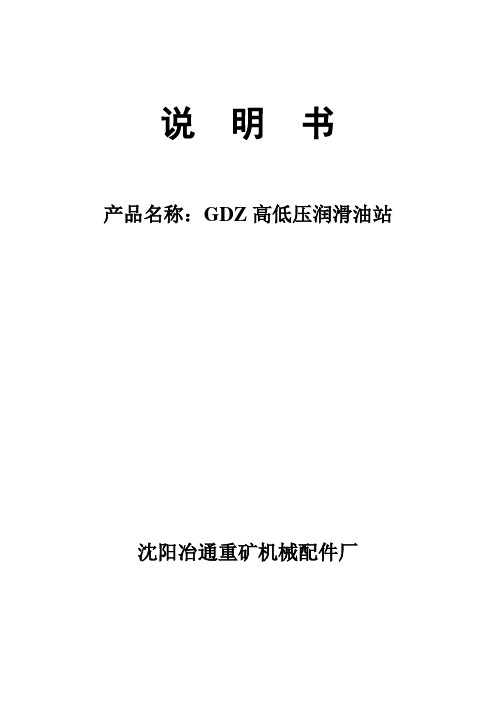
说明书产品名称:GDZ高低压润滑油站沈阳冶通重矿机械配件厂1用途高低压润滑站是为球磨机静压轴承的润滑和压力油而设计的,其润滑介质的粘度等级N22—N460的工业润滑油。
2技术参数低压泵公称流量:40~63L/min公称压力:0.4MPa高压泵公称流量:2.5L/min公称压力:31.5MPa油箱容积:1.25m2过滤面积:0.2 m2过滤精度:0.08mm换热面积:5.5 m2 (如增加冷却面积订货时应说明)冷却水耗量:5 m3/h冷却水温度:≤28℃加热功率:18KW3润滑站主要部件及主要元件油箱、低压泵装置、高压泵装置、列管式冷却器、双筒网片磁式滤油器、仪表及电气元件、电控系统等组成。
4系统原理(见系统原理图)5调试5.1低压泵压力的调整按系统图所示,关闭阀1、3、4、5、7、启动低压泵(一台工作,另一台备用),这时安全阀的调压弹簧是松开的,滤油器的换向阀应在工作位置“左开”或“右开”,然后逐渐拧紧安全阀的弹簧,使压力表上的压力升到0.4MPa为止。
检查各连接处的泄漏情况,若无异常,继续拧紧安全阀的弹簧,使压力达到0.5MPa时为止。
运转5分钟,检查各连接处均不得有泄漏现象。
然后逐渐拧松弹簧,直到压力恢复到0.4MPa为止。
5.2高压泵压力的调整在低压泵继续运转的状态下,启动两台高压泵,这时直动型溢流阀的弹簧应该是松开的,然后逐渐拧紧溢流阀的弹簧。
使压力表上压力达到31.5MPa时为止,运转5分钟后检查各连接处均不得有泄漏现象;再将压力调到设定值为止,锁紧溢流阀。
5.3矫正铂热电阻在比率计上的温度值,本站共设有两个铂热电阻,一个设在低压油出口的油包上,另一个设在油箱前壁的下部位置。
5.4压力控制松开阀门1,使系统压力稳定在0.15MPa,当压力低于0.1MPa 时,压力控制器的一接点启动备用泵,这时,控制箱上的警笛响,并有一个表示备用泵在工作的信号灯燃亮,直到压力恢复正常,信号消失。
如果备用泵投入工作后,系统压力继续下降至0.05MPa时,由另一压力控制器的接点发出事故信号,应停止主机工作,直到故障排除。
磨煤机润滑油站说明书
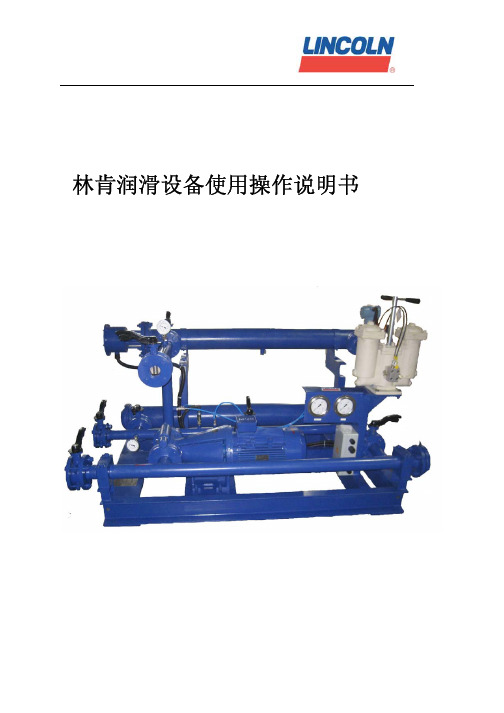
.sg
1
用户手册
OCS作手册
一、总则
此手册指导用户正确使用本润滑系统,包括运输、安装、调试、操
润滑站使用说明书
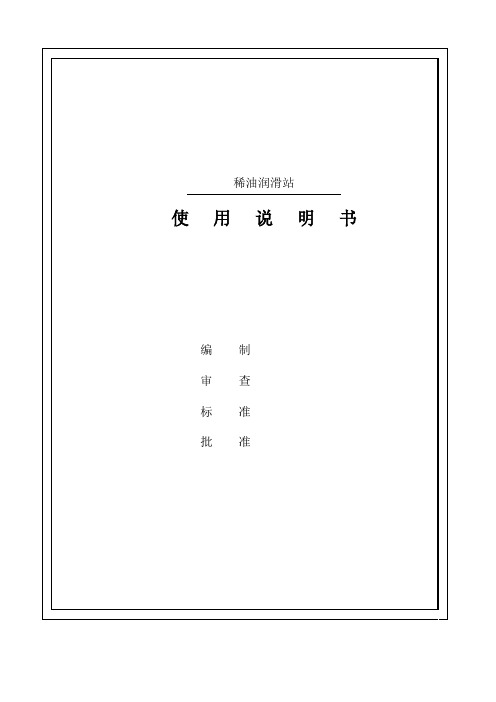
目录1 概述 22 主要技术参数 23 工作原理与结构特点 24 主要控制要求 45 吊运与储存 56 安装、调整和试运转 57 操作规程 68 维护与保养 6特别注意:用户在使用和操作前,应认真阅读本说明书。
本说明书的解释权归洛阳机械公司自动化公司液压所。
本说明书如有改动,恕不另行通知。
联系地址:河南省洛阳市邮编:471039电话(Tel): 1一、概述本稀油润滑站主要用于减速器的润滑,对于延长设备使用寿命,降低磨损、减少功率消耗起到良好的效果。
该油站是工作介质粘度等级为N22-N320的工业润滑站。
二、主要技术参数最大工作油压最大供油量63L/min供油温度 <40℃油箱容积 750L滤油器过滤精度 50μm滤油器额定流量 100L/min电动机参数 Y100L1-4B5电加热器功率 3X2 KW冷却面积 3 m2冷却水耗量 3 m3/h冷却器进水压力—冷却器进水温度 <30℃外形尺寸(长X宽X高) 1705X975X1300mm重量 600kg三工作原理及结构特点1. 工作原理:齿轮泵从油箱中吸出润滑油,经滤油器,单向阀,冷却器,及截止阀后,再经中间配管被直接送到设备的润滑点,经过润滑点的润滑油经中间配管,再通过油箱内安装的回油过滤器,过滤后流回油箱。
这样循环往复,可以保证润滑系统正常工作。
润滑站的工作压力取决于润滑点的开口量,润滑站出口与润滑点之间的标高差,管路长度和弯头数量及出油阀门开度等因素影响。
系统的最高工作压力为,最底工作压力为—,根据润滑点的情况,通过调节安全阀确定使用压力.系统的过压保护由安全阀来完成,工作中当润滑站的工作压力超过安全阀调定压力时,安全阀将自动打开,多余的油液流回油箱,使油压保原理图 主要元件:1.数显压力表白 2。
电接点温度计 3。
压力表 4.温度控制器 5。
压力控制器 6。
安全阀 7.回油过滤器材 8。
油箱 9。
电加热器 10.浮球式液位控制器 11。
稀油站_XYZ-6G~125G说明书
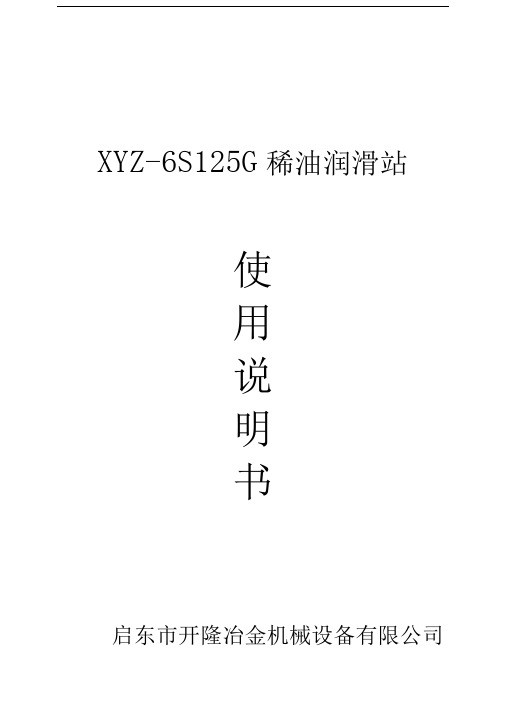
XYZ-6S125G稀油润滑站使用说明书启东市开隆冶金机械设备有限公司一设备的用途XYZ-6G- 125G型稀油站主要用于冶金、矿山、能源、建材、轻工、交通、运输等机械设备的稀油循环润滑系统中,向减速器、齿轮座、主电动机轴承等摩擦部位供送润滑油。
起减磨和冷却作用,确保主机设备连续正常运行。
本稀油润滑站使用工作介质粘度等级为N22〜N460的工业润滑油。
循环冷却采用列管式冷却器。
本油站通常是安装在主机附近或地下油库内、地坑内。
、设备性能参数三、工作原理及结构特点XYZ-G型稀油站主要由油箱、立式齿轮油泵装置、单向阀、安全阀、双筒网片式过滤器、列管式油冷却器、压力控制器、电接点双金属温度计、铂热电阻、仪表、管道及阀门等组成,并配套相应的电控系统。
XYZ-6G〜125G为整体式小型稀油站。
其外形详见设备外形图。
工作时,润滑油由齿轮泵从油箱吸出,经单向阀、双筒网片式过滤器、列管式油冷却器,被直接送到设备的润滑点。
油站的最高工作压力一般为0.4MPa,最低工作压力为O.IMPa。
油站的实际工作压力根据现场条件而定,关键是能否提供足够的流量。
根据润滑点的要求,通过调节安全阀确定使用压力,当油站的工作压力超过安全阀的调定压力时,安全阀将自动打开,油液即溢流回油箱。
安全阀的作用是当系统过载时溢流,卸压保护系统。
压力控制器用来检测系统的压力,铂热电阻用来检测润滑油温度。
油箱可储油和散热并分离油液中的气体及沉淀污物。
稀油站的结构有以下特点:1、设有备用油泵:稀油站有两台油泵装置,一台工作、一台备用,正常情况下工作油泵运行,当系统压力低于压力控制器调定值时,备用油泵投入工作。
确保向主机连续提供符合压力要求的润滑油。
2、双筒网片式油滤器放在列管式冷却器之前:油在油滤器中的通过能力与其粘度有关。
粘度大,通过能力差,反之通过能力好。
温度高,则粘度下降,通过能力好过滤的效果也较好,先过滤后冷却即达到此目的。
3、米用双筒网片式油滤器双筒网片式油滤器有两组过滤滤芯。
润滑站使用说明书

润滑站使用说明书
1、概述
随着液压传动技术的不断发展和完善,为更有效地提高JK系列矿井提升机的产品质量和使用可靠性,我们设计了TD-RH型矿井提升机润滑站。
该润滑站结构简单操作方便,有效稳定的向减速机提供润滑油,大大提高了减速机的使用寿命和性能。
TD-RH润滑站的主要作用是:可以为减速机提供流量稳定的润滑油,以使减速机获得最好的润滑。
2、TD-RH润滑站的主要技术参数:
润滑站额定工作压力:0.2MPa
润滑站最大工作流量:25L
油箱容积:300L
正常工作油温:15℃-60℃
液压油牌号:夏季:L-CKC46~68
冬季:L-CKC100~150
油泵驱动电机:YB290L-6-B5 1.1KW
润滑站油液清洁度:NAS1638-10级
3、润滑站的结构原理:
TD-RH润滑站原理图见附图1、装配图见附图2。
润滑站的动力源由两台齿轮泵-电机组组成。
它们一开一备,由于每台油泵出口装有止回阀,所以当一台油泵或电机损坏需维修更换时,可不停机进行更换。
4、工作原理:
开机前打开8铜球阀,一台电机通电,润滑站工作,润滑油由齿轮泵吸入油管,经止回阀流入集成块再流出,根据实际情况调节8铜球阀进行调压,压力调节范围在0.1MPa~0.2MPa,调整减速机油标窗口,使液面在中上部位。
5、注意事项
提升机运转之前必须开启润滑站。
润滑油要定期更换确保润滑油的清洁。
干油润滑系统说明书
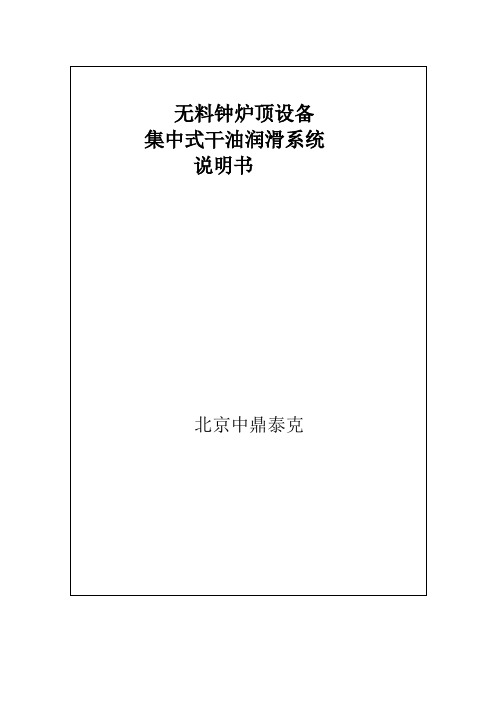
目录1.滑系统说明书2.润滑系统图3.电控柜使用和维修4.泵站及其原理图5.电控原理图(一)6.电控原理图(二)7.电控原理图(三)8.电控柜外形图9.电控柜内部元件图10.电控柜JD1和JD2端子排接线图11.泵站端子接线图无料钟炉顶集中式干油润滑系统一、系统构成系统由2个不同的润滑周期组成。
通过2个自动二位四通阀来分别单独驱动2个润滑周期;●4小时润滑周期(包括上密阀、料流阀、柱塞阀、及均压阀、放散阀)●45分钟润滑周期(包括溜槽传动齿轮、行星齿轮箱、下密封阀)干油润滑系统按双管线原则工作,基本组成如下;●润滑泵—主泵和备用泵。
●两位四通换向阀—直流电机控制的两位四通换向阀把泵提供的润滑油送入与干油分配器连接的主管中。
●干油分配器—输送一定设定量润滑油到润滑点,这与通过输送管到相应润滑点的背压无关。
●终端压力开关—其压力已设定好,此压力开关将使泵停机,其在预定时间结束后启动两位四通换向阀使其换向。
输送到干油分配器2组相反出口的润滑点的润滑油量可以满足不同润滑需求量。
另外,可以通过更多的支管及连接更多的干油分配器来扩大系统。
只要泵的压力和润滑油输出量允许这样做。
通过装在同一润滑系统内不同润滑周期的几个换向阀可以随意地把系统分成几个支系统。
1.1带干油箱的集中润滑泵站泵站装有以下安全装置1.1.1电液压力开关压力开关的目的是:当压力到达预定的最大压力时断开润滑泵的电机驱动,从而保护泵和电机。
压力开关在预设压力(160—400bar)断开泵的电机。
(目前定为250bar)1.1.2压力表用于目测工作压力。
1.1.3过滤器阻止杂质进入主管路1.1.4安全阀如果电液压力开关失效,安全阀作为最后防线可保护泵不受太高的压力而损坏,安全阀的设定压力为410bar且是防堵塞的1.1.5液位控制机构30升的油箱的高低液位控制是借助于随动板及限位开关完成的。
它将油箱的油位正常和低油位的信号反馈到电控柜以及油箱旁的指示灯(红色灯表示油位低)(但我们只采用了油箱的低油位报警控制功能)油箱的液位被检测,如果达到了报警下线则发出报警信号,泵将被断开。
润滑站使用说明书

润滑站使用说明书
润滑站使用说明书
1、概述
随着液压传动技术的不断发展和完善,为更有效地提高JK系列矿井提升机的产品质量和使用可靠性,我们设计了TD-RH型矿井提升机润滑站。
该润滑站结构简单操作方便,有效稳定的向减速机提供润滑油,大大提高了减速机的使用寿命和性能。
TD-RH润滑站的主要作用是:可以为减速机提供流量稳定的润滑油,以使减速机获得最好的润滑。
2、TD-RH润滑站的主要技术参数:
润滑站额定工作压力:0.2MPa
润滑站最大工作流量:25L
油箱容积:300L
正常工作油温:15℃-60℃
液压油牌号:夏季:L-CKC46~68
冬季:L-CKC100~150
油泵驱动电机:YB290L-6-B5 1.1KW
润滑站油液清洁度:NAS1638-10级
3、润滑站的结构原理:
TD-RH润滑站原理图见附图1、装配图见附图2。
润滑站的动力源由两台齿轮泵-电机组组成。
它们一开一备,由于每台油泵出口装有止回阀,所以当一台油泵或电机损坏需维修更换时,可不停机进行更换。
1。
ZKDP-P矿用智能集中润滑系统说明书

ZKDP-P型智能集中润滑系统说明书一、系统简介1. ∙ ZKDP-P型智能集中润滑系统,是本公司研制开发的新一代润滑技术产品。
该系统由主控设备、高压润滑脂泵、电动球阀、油路、控制及信号线路组成。
2.主控设备控制油泵定时定量加油,加油时间和间隔时间根据轴承大小随机设定.控制箱具有有线和无线传输功能,可将现场数据传输到中控室或手机上。
3.高压润滑脂泵通过一条主管路把油脂送至各个加油点附近; 在每处加油点处用三通从主管路上接出一支分管,连接到电动球阀箱,再用高压软管连接到各个加油点,实现加油功能. 每支管路都安装有溢流阀,一旦加油点堵塞溢油口出油,需要及时清理.4.适应单台设备或多台设备的各种润滑要求。
1、主控设备作为润滑系统的指挥中心,其主要功能:控制油站启停控制电动球阀的运行现场信息收集监控每一个润滑点的润滑状态调节和显示循环时间调整每一个润滑点供油量故障报警与厂内主机联锁(可选)2、油站作为润滑系统的心脏设备,它的主要功能:将润滑脂输送到管路,通过管路及电动球阀,最终输送到每一个润滑点。
3、电动球阀作为润滑系统的执行机构,其主要功能:执行主控系统送来的指令,控制油阀开启、关闭,实现控制润滑点的供油。
将信息反馈给主控系统。
系统中主控设备、高压电动油泵、电子控制球阀、堵塞溢流装置等设备采用SIEMENS S7-200系列可编程控制器作为主要控制系统,为润滑智能控制需求提供了最恰当的解决办法,可网络挂接与上位机计算机系统进行连接以实时监控,使得润滑状态一目了然;现场供油分配直接受可编程控制器的控制,供油量大小,供油循环时间的长短都由主控系统来完成;如有故障及时报警,且能准确判断出故障点所在,便于操作工的维护与维修。
操作员可根据设备各点润滑要求的不同,通过文本显示器远程调整供油参数,以适应设备不同部位支持、轴承的润滑要求。
整个润滑系统的供油部分,通过公司最新研制的高压电动润滑泵将润滑脂注入到相应的润滑点上,油泵的供油压力可达到40MPa,根据距离远近调整压力大小,调压范围在0-40MPa 之间。
装车站自动润滑系统的组成工作原理及使用说明

装车站自动润滑系统的组成、工作原理及使用说明天地科技股份有限公司储装自动化研究院2014.111.自动潤滑系统形式采用双线自动集中润滑系统,可以向系统内所有的润滑点定时、定量供送润滑脂。
该系统具有如下优点:1)给油定量准确。
分配器采用容积计量,给油量不受外界因数影响。
分配器设置了给油量调节机构,可以调节每一点的给油量。
2)工作可靠。
只要润滑泵有足够的压力,分配器即可动作。
3)系统扩展方便,系统安装后需要增加或减少润滑点都很方便。
4)环境适应性强。
某些润滑点堵塞不会影响其它润滑点给油。
5)每一个润滑点是否得到供油可以直接观察。
6)可以组成较大的润滑系统。
2. 系统的组成和工作原理系统主要由电动干油润滑泵装置一套(包含电动干油润滑泵及两位四通电动换向阀各一台)、压力控制器两台、双线分配器若干台、双线分配器若干台、电气控制箱一套以及两条主管路、分支管路及管路附件组成。
其中压力控制器安装在系统主管路的首端,用于监控系统两条主管路的压力。
电动润滑泵输出的润滑脂经过换向阀交替由两条主管路输送到双线分配器的进油口。
主管路Ⅰ供送压力润滑脂时,管路Ⅱ向润滑泵的贮油器开放。
双线分配器的活塞由压力润滑脂推动,只要管路内的压力达到分配器动作所需的压力,分配器的活塞即动作,将定量的(1.5ml)润滑脂挤压到润滑点。
随着管路内的压力继续上升,系统中的分配器将依次动作,润滑点得到一次供油,系统完成了一次给油过程。
管路Ⅰ内的压力继续上升,当主管路Ⅰ的压力达到压力控制器的设定压力时,安装在该管路上的压力控制器发出信号,电控箱控制两位四通换向阀切换供油方向,管路Ⅱ向系统供送润滑脂,管路Ⅰ向润滑泵贮油器开放,卸荷。
随着管路Ⅱ内压力的上升,分配器的活塞向上述相反的方向动作,将定量的(1.5ml)润滑脂挤压到润滑点。
当主管路Ⅱ的压力达到压力控制器的设定压力时,安装在该管路上的压力控制器发出信号,换向阀再次切换供油方向,系统完成了一个给油循环。
川润XGD高低压稀油润滑装置说明书
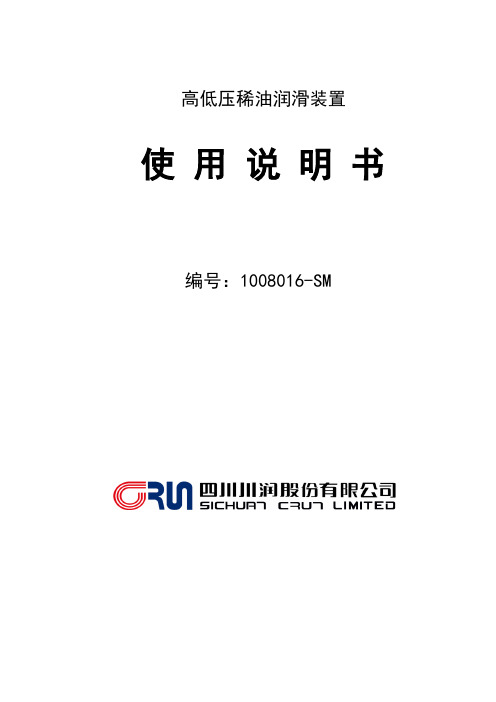
高低压稀油润滑装置使用说明书编号:1008016-SM目录概述 (1)主要性能参数 (1)工作原理 (2)试运转、调试 (4)维护和安全技术 (5)概述:本高低压稀油站,主要用于立磨减速机,对静压油膜轴承与齿轮箱提供润滑。
稀油站主要由螺杆泵(低压)装置(两台)、轴向柱塞泵(高压)装置(四台)、双筒网片式过滤器(两台)、油冷却器、油箱、阀门、管道等组成,稀油站为分体式结构。
本润滑装置由高低压稀油润滑站、仪表盘、补偿装置、电控柜配套组成。
1、主要性能参数:1.1低压供油系统:1.1.1螺杆泵(低压)装置型号: 3Gr85×2(2台)公称流量: 631 L/min公称压力: 1 MPa正常工作压力:0.2-0.4 MPa电机型号: Y180L-4B3转速: 1470 r/min功率: 22 kW1.1.2过滤器型号: SPL80X SPL65X过滤精度: 0.08 mm 0.04 mm1.1.3油冷却器型号: C5-1.0/50-NⅦB工作压力: 0.63 MPa热交换系数:≥300 Kcal/m2.h.℃冷却水用量:≥38 m3/h1.1.4电加热器型号: HRY5-380/6功率: 6kW×6=36 kW1.1.5油箱有效容积: 6.5 m31.1.6油站外形尺寸:~5350×2180×2300(长×宽×高)1.1.7工作介质: N220~N320 极压工业齿轮油1.2 高压系统:径向柱塞泵(高压)装置型号: SC-047 (4台)公称流量: 4×47 L/min公称压力: 32 MPa系统最高工作压力:≤14MPa(暂定)电机型号: Y200L1-6B35电机转速: 970 r/min功率: 18.5 kW2、工作原理:2.1油站为整体式结构(见外形图),油站工作原理图(见系统图),润滑站由低压供油系统与高压供油系统组成,低压油出口除直接提供齿轮润滑外,同时对高压泵吸油口供油,四台高压泵形成分十六路高压供油系统直接将高压油输送至各油腔。
高低压稀油润滑站使用说明书

中信重工股份有限公司
高低压稀油润滑站
代号
TM339CSM
使用说明书
共9页
第6页
6.3温度控制值的调定:
按系统工作油温,将油箱和出油管道上的电接点温度计的设定值调到相应的位置。具体设定值如下:
高压供油系统:磨机启动前,或要停止时向主轴承输送高压油,石磨机的主轴承浮起,在主轴与球面瓦之间形成一定厚度的油膜,以降低磨机的启动力矩;或避免磨机停止时,因他的转速过低,行不成一定厚度的油膜,导致主轴与球面瓦的直接接触,造成烧瓦事故。使用本润滑站,可延长球面瓦的使用寿命。
低压供油系统:磨机正常运转时,起动压润滑和冷却主轴承的作用。可降低磨损,延长设备使用寿命,减少功率消耗。
6.5.2调试高压系统:
将出油口阀门打开,分别用手盘动每个电机泵装置的联轴器,应无卡阻感觉;点动检查,电机转向应正确。
启动高压油泵电机,观察压力表,压力升高并稳定在一个数值上(即正确工作油压,一般在3.0-18.0MPa之间),运转10min,各焊缝及接口处应无漏油及其它现象。用仪表测量磨机的主轴的浮起量,应达到主机的要求。这时,高压系统进入正常工作状态。
在高低压供油系统均进入正常工作状态时,主机才可以启动,主机运转正常后,经一段时间延迟后(15分钟可调),高低压供油系统应自动停止工作。
在磨机处于慢驱传动工作方式时,高压供油系统应一直处于正常工作状态,直到操作人员认为合适时,人工停止高压供油系统工作。
主机停机的同时,启动高压油泵电机,高压供油系统应在正常油压范围内工作。
TM339CSM
四川川润润滑油站XRZ-125说明书
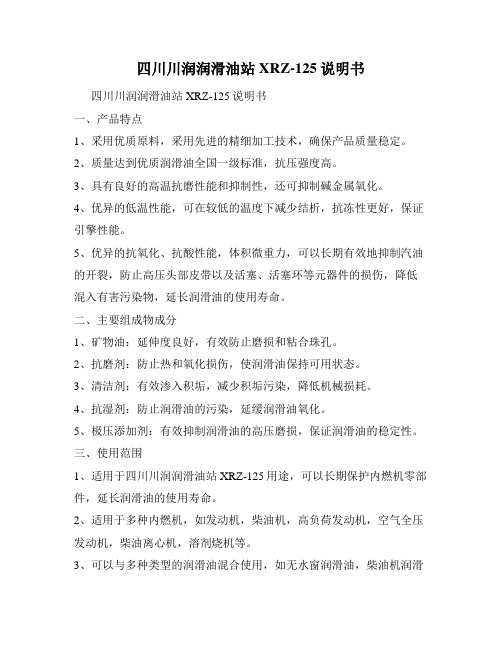
四川川润润滑油站XRZ-125说明书四川川润润滑油站XRZ-125说明书一、产品特点1、采用优质原料,采用先进的精细加工技术,确保产品质量稳定。
2、质量达到优质润滑油全国一级标准,抗压强度高。
3、具有良好的高温抗磨性能和抑制性,还可抑制碱金属氧化。
4、优异的低温性能,可在较低的温度下减少结析,抗冻性更好,保证引擎性能。
5、优异的抗氧化、抗酸性能,体积微重力,可以长期有效地抑制汽油的开裂,防止高压头部皮带以及活塞、活塞环等元器件的损伤,降低混入有害污染物,延长润滑油的使用寿命。
二、主要组成物成分1、矿物油:延伸度良好,有效防止磨损和粘合珠孔。
2、抗磨剂:防止热和氧化损伤,使润滑油保持可用状态。
3、清洁剂:有效渗入积垢,减少积垢污染,降低机械损耗。
4、抗湿剂:防止润滑油的污染,延缓润滑油氧化。
5、极压添加剂:有效抑制润滑油的高压磨损,保证润滑油的稳定性。
三、使用范围1、适用于四川川润润滑油站XRZ-125用途,可以长期保护内燃机零部件,延长润滑油的使用寿命。
2、适用于多种内燃机,如发动机,柴油机,高负荷发动机,空气全压发动机,柴油离心机,溶剂烧机等。
3、可以与多种类型的润滑油混合使用,如无水窗润滑油,柴油机润滑油,车用润滑油等。
四、存储及保护1、存储时应将润滑油放在干燥、阴凉通风的地方,且与易燃物品、有毒物品等保持一定的距离。
2、润滑油可在0~45℃范围内存储。
应定期检查其质量,检测若存在过滤、污染等现象,应及时更换润滑油。
3、保护时应检查润滑油箱液位是否正确,若受到外界环境污染等因素,应及时清除。
4、建议定期将润滑油更换,使润滑油保持良好的润滑性能。
- 1、下载文档前请自行甄别文档内容的完整性,平台不提供额外的编辑、内容补充、找答案等附加服务。
- 2、"仅部分预览"的文档,不可在线预览部分如存在完整性等问题,可反馈申请退款(可完整预览的文档不适用该条件!)。
- 3、如文档侵犯您的权益,请联系客服反馈,我们会尽快为您处理(人工客服工作时间:9:00-18:30)。
洛阳机械公司
稀油润滑站
使用说明书
代 号 ZA130SM
共6页 第 2 页
一、概述
本稀油润滑站主要用于减速器的润滑,对于延长设备使用寿命,降低
磨损、减少功率消耗起到良好的效果。
该油站是工作介质粘度等级为 N22-N320 的工业润滑站。
二、主要技术参数
最大工作油压
最大供油量
间的标高差,管路长度和弯头数量及出油阀门开度等因素影响。系统的
最高工作压力为,最底工作压力为—,根据润滑点的情况,通过调节安全阀
确定使用压力.
系统的过压保护由安全阀来完成,工作中当润滑站的工作压力超过
安全阀调定压力时,安全阀将自动打开,多余的油液流回油箱,使油压保持
在正常数值上,实现过载保护。详见原理图.
63L/min
供油温度
<40℃
油箱容积
750L
滤油器过滤精度
50μm
滤油器额定流L1-4B5
电加热器功率
3X2 KW
冷却面积
3 m2
冷却水耗量
3 m3/h
冷却器进水压力
—
冷却器进水温度
<30℃
外形尺寸(长 X 宽 X 高)
1705X975X1300mm
重量
600kg
润滑站储存时,应放入通风、干燥、不潮湿的室内储存,存放时严禁倒 置和堆垛。若需露天存放时,必须采取有效的防雨、防水、防锈、防盗措施, 以利于产品的安全和防护。
我公司的产品,已选用防锈有效期为 3 个月的油品进行了防锈处理, 如果产品放置的时间超过上述期限或在此期间经受过严重的雨水、洪水冲击 或其它腐蚀,应及时对该包装箱进行拆封检查,重新进行防锈封存,以防止 产品锈蚀。
(7)ZA130 配有专用的电控箱,电控箱有单独的使用说明书。
四 主要控制要求
1.油压控制 在润滑站出油口处设有两个电接点压力表参与压力设定点的控制。
工作时,当出口油压降到某一设定值时(推荐值为),由一块电接点压 力表发出信号,切换备用泵投入工作,工作泵停止。当压力恢复到另一 设定值时(推荐值为),取消报警信号。当压力继续下降或没有恢复到 正常值时,电气将(延时)发出事故报警讯号或主机停机。
13.单向阀门
14。过滤器
16.三通阀
17。冷却器
3。压力表 6。安全阀 9。电加热器 12。空气滤清器 15。电动机
标 记 数量 签 字 日 期 附 注
洛阳机械公司
稀油润滑站
使用说明书
代 号 ZA130SM
共6页 第4页
2.结构特点: (1)该润滑站有两台油泵装置,一台工作,一台备用。正常情况下工
当油压升高至(上限)另一块电接点压力表发出高压报 警讯号。当油压降低到()极限值时,发出低压停车报警信号。 2.温度控制
油箱上设电接点温度计一只,用于控制泵和电加热器。当油箱中的 油温低于温度计下限设定值时,油泵不能启动,电加热器通电,自动投 入工作。当油温升高达到温度计下限设定值时,油泵可以启动。当油温 升高到温度计上限设定值(30℃)时,电加热器自动切断。
泵站的排污口阀门用来快速排出油箱中已到更换期、并已不能用
的油.
标 记 数量 签 字 日 期 附 注
洛阳机械公司
稀油润滑站
使用说明书
代 号 TE015SM
共6页 第3页
原理图
主要元件:
1.数显压力表白
2。电接点温度计
4.温度控制器
5。压力控制器
7.回油过滤器材
8。油箱
10.浮球式液位控制器 11。齿轮泵
稀油润滑站
使用说明书
编制 审查 标准 批准
洛阳机械公司
稀油润滑站
使用说明书
目录
1 概述 2 主要技术参数 3 工作原理与结构特点 4 主要控制要求 5 吊运与储存 6 安装、调整和试运转 7 操作规程 8 维护与保养
代 号 ZA130SM
共6页
第1页
2 2 2 4 5 5 6 6
特别注意: 用户在使用和操作前,应认真阅读本说明书。 本说明书的解释权归洛阳机械公司自动化公司液压所。 本说明书如有改动,恕不另行通知。 联系地址:河南省洛阳市 邮编:471039 电话(Tel): 1
作油泵运行,当系统压力低于压力设定值时,备用油泵投入工作,保证向 主机继续供送润滑油。
(2)滤油器放在冷却器之前。由于油在过滤器中的通过能力与其粘 度有关,粘度大,通过能力差,反之通过能力好。温度高时,油粘度下 降,通过能力强,过滤效果好,先过滤后冷却即达到此目的。
(3)采用一台泵配一个过滤器。其中一台工作,一台备用。当工作 滤芯的发讯装置报警,需要换滤芯时,备用泵工作,即可取出原工作滤 芯进行清洗或更换。
六 安装、调整和试运转 稀油润滑站应平稳地安放在普通地面,有无地脚紧固均可。 该润滑站已在厂内进行了出厂性能试验,故在现场安放平稳后,即可
连接出油管、水管、电控箱等。正式装配前先将管子酸洗、去锈,后用石 灰水中和再用清水冲干净,最后用压缩空气吹干,内壁涂防锈油。经试车 合格后可投入使用。
标 记 数量 签 字 日 期 附 注
使用说明书
代 号 TE512SM
共页
第页
标 记 数量 签 字 日 期 附 注
洛阳机械公司
提升机稀油润滑站
使用说明书
代 号 TE512SM
共页
第页
标 记 数量 签 字 日 期 附 注
洛阳机械公司
提升机稀油润滑站
使用说明书
代 号 TE512SM
共页
第页
标 记 数量 签 字 日 期 附 注
3. 油位控制 油箱上设有液位控制器一个,用于控制油箱内油液的上、下限位置。
当油位处于上限位置时,发出灯光显示;当油位处于下限位置时,控制器 发声光报警信号。 4. 滤油器压差控制
两个滤油器各带一个压差发讯器。当滤油器进出油口压差达到或超过 设定值时,发出声光报警信号,更换滤芯.另一台油泵投入工作。
洛阳机械公司
稀油润滑站
代 号 ZA130SM
使用说明书
共6页
第6页
七 操作规程
1.按系统工作压力及工作油温将仪表盘上的两个电接点压力表调节到 相应的设定值,电接点温度计和铂热电阻调节到设定值的相应位置,打开润 滑站相应的阀门和压力表开关。
2.检查列管式冷却器夹紧螺栓,如松动,则需紧固之。 3.在主机工作之前,先开启工作油泵,使系统达到工作压力后再启动主 机工作,主机停止工作后,方可停止油泵。 4.稀油润滑站工作中如因油压、油温、油位处于不正常位置时,应有 相应的信号灯亮,有时还有音响报警,应先解除音响后,再按信号灯显示 部位采取措施。
(4)采用 GLC 型列管式油冷却器,它的换热管采用翘片管,水侧 通道采用双管程的填料函浮动管、板型式。其特点是冷却效果好, 体积小,重量轻,并且压力降大大小于板式换热器。
(5)回油口设有磁性过滤器。可将回油中的细小铁物质吸附过滤, 保证油的清洁。
(6)所有仪表全部安装在仪表盘上。一只压力表用来直接观察和测 量油泵油压。两只电接点压力表控制出油口压力,实现欠压、超压保护。 一个电接点温度计控制出油口油温,另一个电接点温度计控制油箱内的 油温。
5. 流量控制: 在供油输出管路上设一只流量控制器,当管路中油流量小于流量
控制器的设定值时,发出声光报警信号。
五 吊运与储存
润滑站整体吊装是用油箱体上的四个吊环来起吊的,其它应严格按照 GB191-90 规定的包装储运图示标志进行。
润滑站整体运输时,应放入包装箱中,运输过程中严禁将润滑站倒置。 另外,包装箱应具备防雨功能。
标 记 数量 签 字 日 期 附 注
洛阳机械公司
稀油润滑站
使用说明书
代 号 ZA130SM
共6页
第5页
润滑站出油口设电接点温度计一只。当油温升高达到电接点温度计某 一设定值时(45℃)发出光报警信号,手动将冷却水阀打开投入工作,当 温度低于另一设定值时(35℃),发出光报警信号,冷却水阀关闭,冷却器 停止工作。
三 工作原理及结构特点
1. 工作原理:
齿轮泵从油箱中吸出润滑油,经滤油器,单向阀,冷却器,及截止
阀后,再经中间配管被直接送到设备的润滑点,经过润滑点的润滑油经
中间配管,再通过油箱内安装的回油过滤器,过滤后流回油箱。这样循
环往复,可以保证润滑系统正常工作。
润滑站的工作压力取决于润滑点的开口量,润滑站出口与润滑点之
各元件使用维修方法见有关的说明书。
标 记 数量 签 字 日 期 附 注
洛阳机械公司
提升机稀油润滑站
使用说明书
代 号 TE512SM
共页
第7页
标 记 数量 签 字 日 期 附 注
洛阳机械公司
提升机稀油润滑站
使用说明书
代 号 TE512SM
共页
第页
标 记 数量 签 字 日 期 附 注
洛阳机械公司
提升机稀油润滑站
八 维护与保养
1. 齿轮油泵轴密封圈要经常检视,如有泄露油现象或损坏时,应立 即更换。
2.滤油器每三个月拆洗一次,去除内部淤存之污垢。 3.回油过滤器每三个月清洗一次。 4.注意检视油箱内最低油位处,如发现水,则应打开油箱下部的截止 阀将水放出。
5.列管式冷却器必须根据水质情况,每 6 至 12 个月进行一次内部检 查与清洗。
